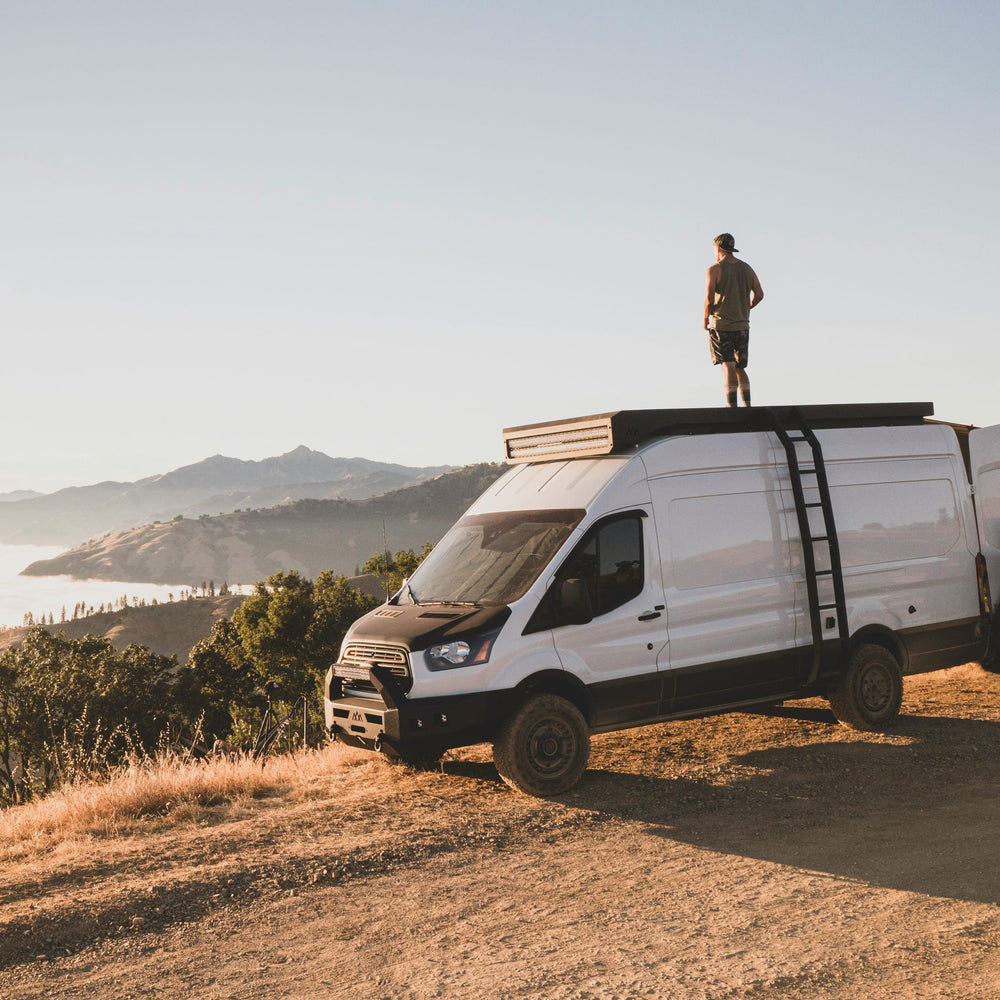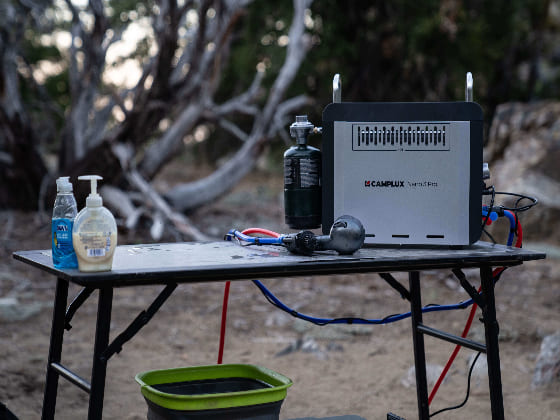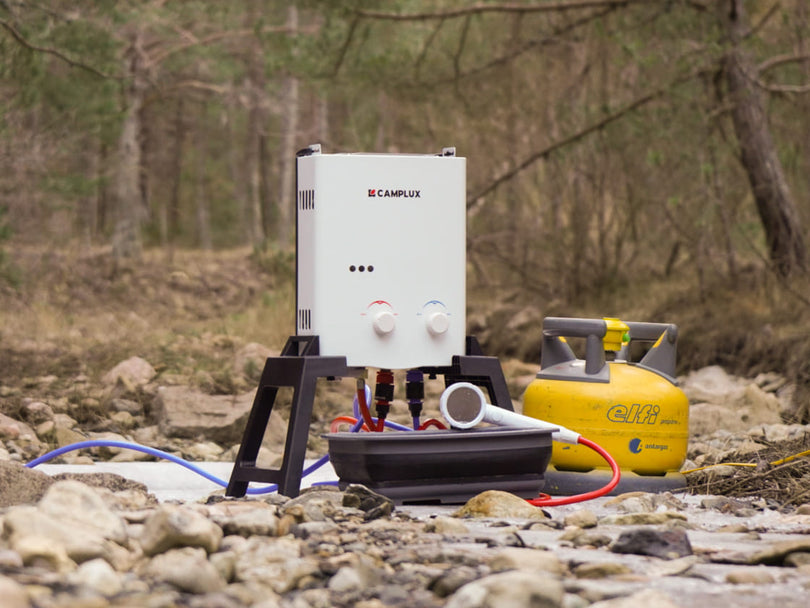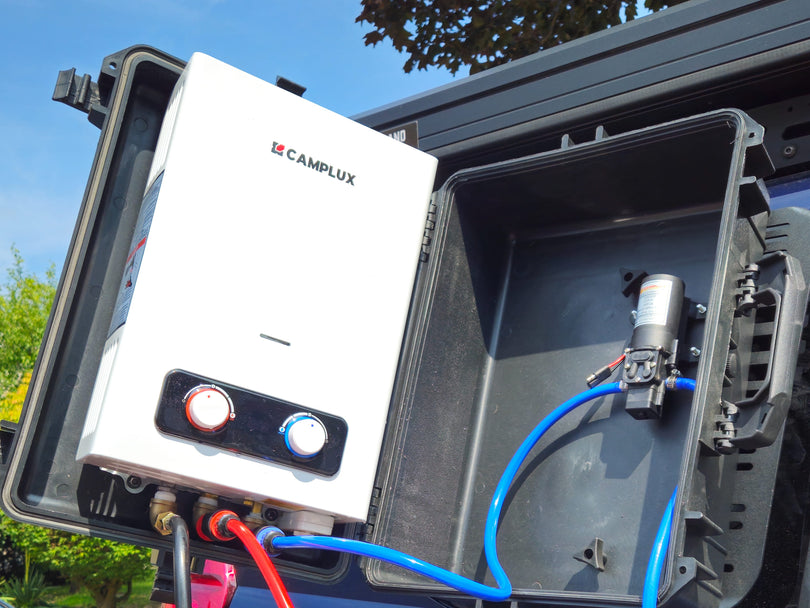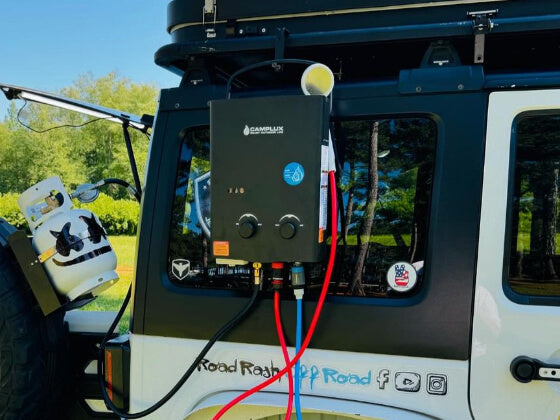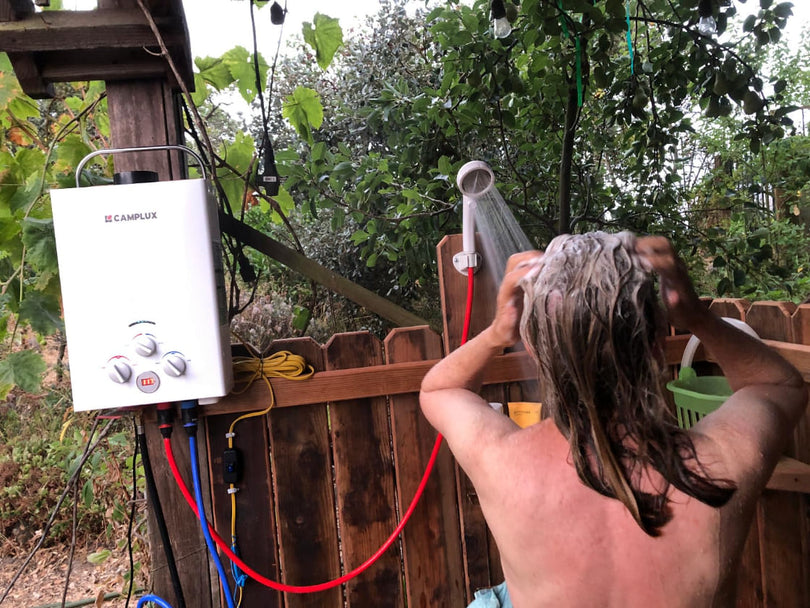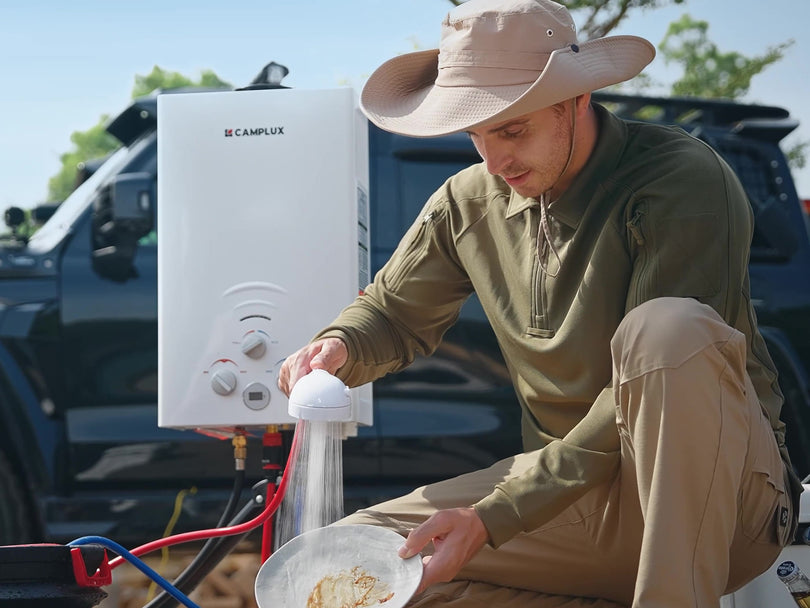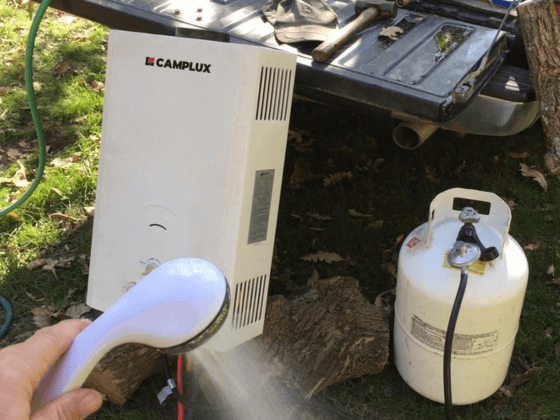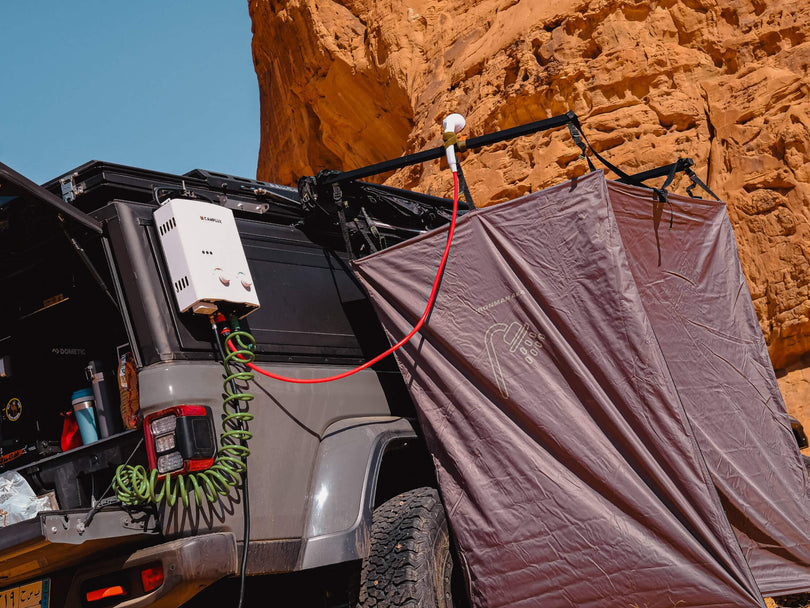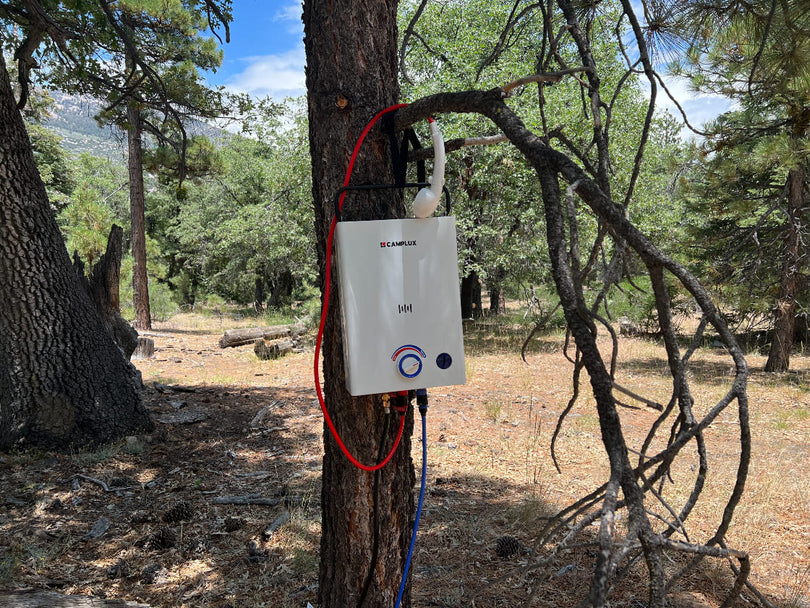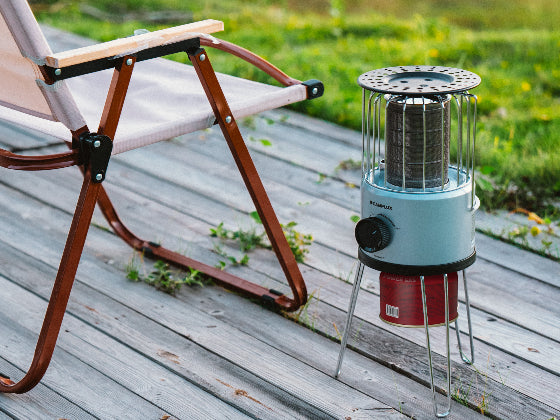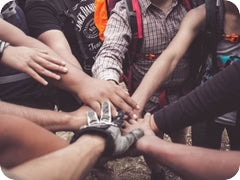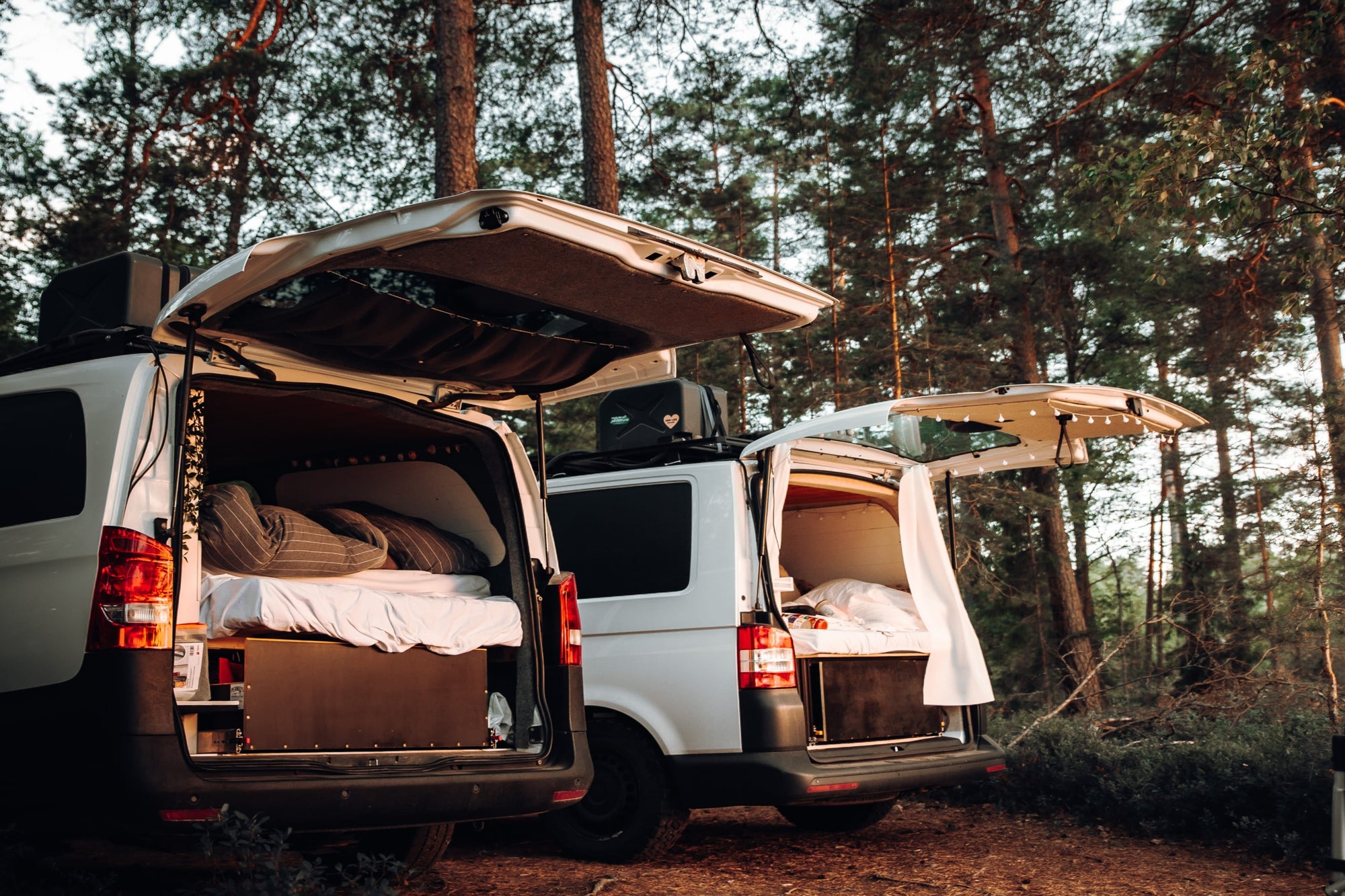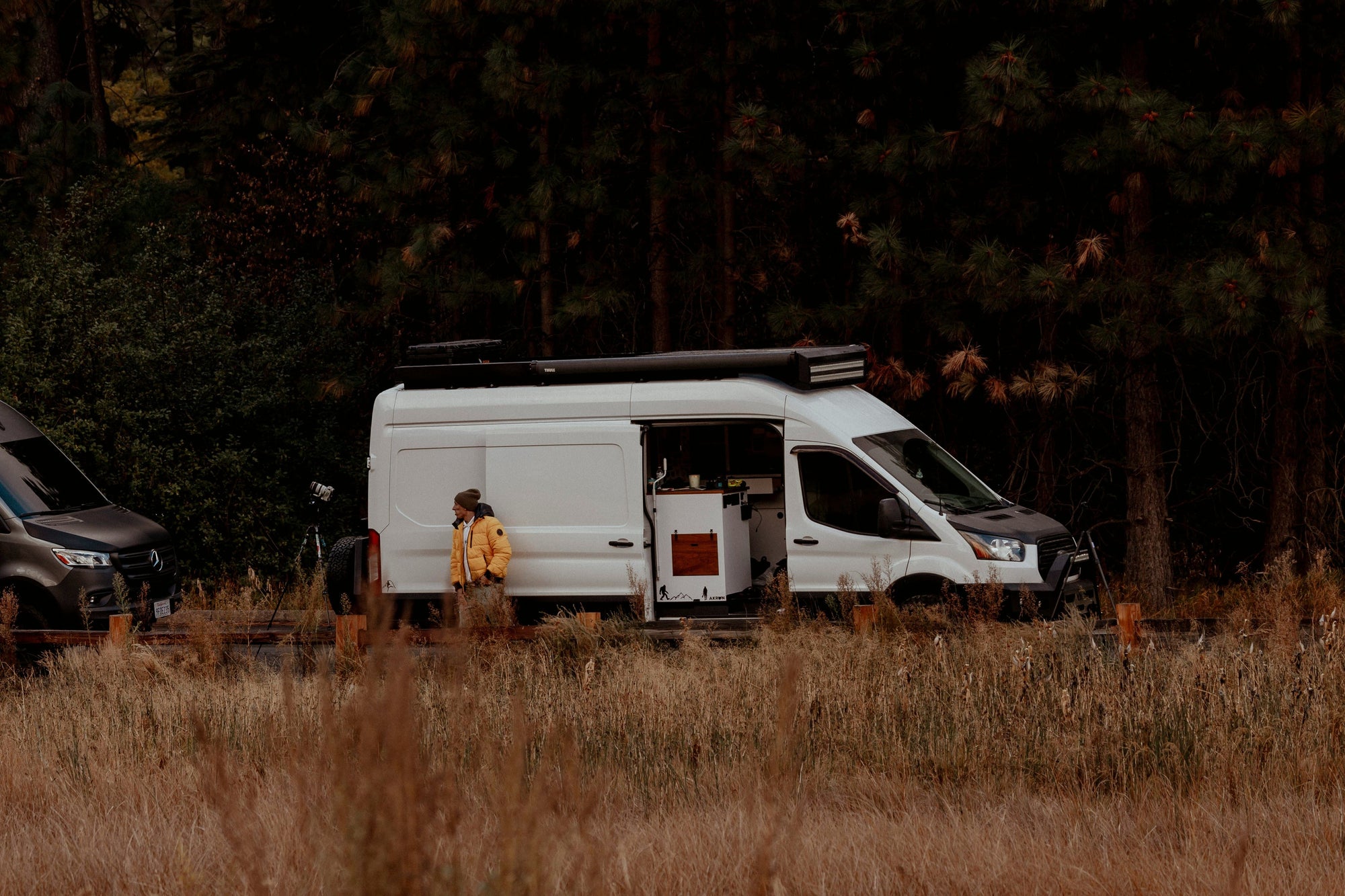Whether you're camping in the Highlands, touring the Lake District in a caravan, or living off-grid, a hot shower can be the ultimate comfort. Camplux propane water heaters make it easy to enjoy instant hot water outdoors – but safety must always come first. Gas-powered appliances require proper handling to protect you, your family, and your adventures. In this UK-focused guide, we'll cover essential gas safety tips for operating your Camplux water heater (like the Nano 3 Pro, AY132B, AY132MAX, BW158BC, BW422, and BW528B models) in off-grid and camping scenarios. You'll also learn about built-in safety features of these units, best practices for setup and use, and what to do if something unexpected happens. Let's ensure that every hot shower you take in the wild is as safe as it is satisfying.
Camplux Nano 3 Pro is a lightweight, portable propane water heater ideal for off-grid adventures. It runs on propane or butane and features a built-in battery for ignition, delivering 3 L/min of hot water on demand. Always operate portable gas units like the Nano 3 Pro outdoors or in well-ventilated areas – never in enclosed spaces like tents or caravans, to avoid carbon monoxide risks
Built-In Safety Features of Camplux Water Heaters
Camplux is a brand built with safety in mind. Understanding the safety features of your specific model will give you extra peace of mind and help you operate it correctly. For example, the Camplux AY132B (5 L) has multiple protection systems: flame failure protection (to cut off gas if the flame goes out), overheat protection, and an oxygen depletion shut-off sensor. This means if oxygen gets low – say, in a small enclosed area – the unit will shut off to prevent danger. The AY132B also has a drainage plug to empty water after use, preventing freeze damage in cold weather. Its sibling, the AY132MAX, shares these safety features and comes with a 4.3 L/min pump and a freestanding stand, ensuring stable operation even in areas with low water pressure or uneven ground.
Larger models like the Camplux BW158BC (6 L) and BW422 (16 L) are designed for more demanding outdoor use (gardens, horse stables, outdoor showers, etc.) and include comprehensive safety features. The Camplux 6 L portable (BW158BC) is CE certified to UK/EU standards and equipped with flame failure and overheat protection, plus a 20-minute automatic shutoff timer that turns the burner off if the water runs continuously for 20 minutes. This prevents accidental overheating and reminds users not to leave the heater running unattended. The BW158BC also includes a weatherproof rain cap on top, which stops rain or debris from entering the flue – perfect for Britain's unpredictable weather. Stepping up in capacity, the Camplux BW422 (16 L) and the BW528B (20 L) can even supply multiple outlets at once. They feature similar safety cut-offs and a Full/Eco switch on higher models (like the BW528B) to let you reduce gas consumption on milder days. No matter the size, every Camplux outdoor unit is designed to shut off gas automatically for flame failure or low oxygen, keeping you safe even if conditions change unexpectedly.
It's reassuring to know your water heater has these safeguards – but your behavior and setup are just as important. Relying on built-in features alone isn't enough; you must follow best practices whenever you connect and use a gas appliance outdoors. Let's go through the essential gas safety tips that apply to all Camplux models and outdoor setups.
Gas Safety Best Practices for Outdoor Water Heaters
Keeping safe with a propane or butane water heater comes down to a few key principles. Before each trip or installation, make sure you've covered the following gas safety best practices:
-
Always use in open, ventilated spaces: Operate your Camplux heater outdoors or under a very well-ventilated shelter only. Never use gas appliances inside a tent, vehicle, enclosed awning, or any unventilated space. All gas burners produce carbon monoxide, which can build up dangerously in closed areas. For example, even though the Camplux BW158BC has a rain cap for outdoor use, you still must leave plenty of clearance above and around the flue for exhaust gases to dissipate safely. Do not attempt to use these “outdoor” models indoors – if you need hot water inside a cabin or camper, consult a professional for a properly vented solution. It's also wise to keep a battery-operated carbon monoxide detector in your caravan or near your tent as an extra precaution in case fumes ever blow back your way.
-
Match the cylinder, regulator and hose to your unit: In the UK, most portable gas water heaters run on LPG – typically propane or butane. Use the correct gas type and regulator specified for your model. Camplux portable heaters usually come with a 37 mbar propane regulator (for the standard UK patio gas bottle with 27 mm clip-on connection). If you plan to use butane, you'll need a 28–30 mbar regulator suited for butane cylinders. Check that your gas hose is in good condition and of the proper length (usually the hoses provided by Camplux are already sized for safe use). Do not shorten or extend the hose with incompatible fittings, and never use tape or sealant on the regulator connection unless the manufacturer explicitly advises it. In fact, Camplux warns not to apply Teflon (PTFE) tape between the regulator and the heater's gas inlet, as this can prevent a proper seal – a common cause of leaks. The rubber washer on the regulator is sufficient for the seal; adding tape might actually cause gas to escape. Always double-check that the regulator is fully tightened and clipped on correctly before turning the gas on.
-
Perform a leak test every time you set up: Each time you connect a new gas bottle or reinstall your heater, perform a simple leak test. Mix a bit of washing-up liquid with water and spray or brush it on all gas connections (the bottle valve, around the regulator attachment, and where the gas hose attaches to the heater). Open the gas valve (without turning the heater on) and watch for bubbles forming on the soapy areas. Bubbles mean there's a gas leak. If you see any, immediately turn off the gas, tighten the connections, and test again. Never ignite the heater if you suspect a leak. Always resolve leaks before use, and if a leak persists and you cannot fix it, the regulator or hose may need replacement. This simple test only takes a minute and can prevent fire hazards or worse. (For more on emergency steps, see What to Do in Case of a Gas Leak from Your Water Heater.)
-
Use stable mounting and keep clear of flammable items: Set up your water heater securely to avoid it tipping over or overheating nearby materials. Most Camplux models either hang on a bracket or come with a stand (e.g. the AY132MAX's freestanding base). Mount the heater at a safe height as instructed in the manual – typically at least 1.5 metres off the ground for proper burner clearance. Ensure the unit is vertical and stable. Keep the area around the heater clear: no loose tarps, towels, leaves, or any flammable materials near the burners or exhaust vent. The front of the heater, where hot exhaust comes out, should face open air. If you're using a portable shower tent or enclosure, keep the top vent open and do not fully close the tent while the heater is running. Always have the shower head pointing away from the heater unit so water spray doesn't hit the flame directly. Wind can be another factor – a strong gust could potentially extinguish the flame or push flames toward surfaces, so consider using a wind guard or placing the unit in a spot shielded from direct wind (but never completely enclosed). Camplux units like the BW158BC and BW422 include protective features like flame failure shut-off in case of sudden flameouts, but it's best to avoid situations that trigger these for a smoother (and safer) hot water experience.
-
Never leave the heater running unattended: It might be tempting to set the heater going and walk away, but you should always supervise an operating gas appliance. Camplux heaters will automatically shut off after 20 minutes of continuous run time as a safety measure. This timer helps prevent overheating and reminds users to check on the unit. If you reach the 20-minute cut-off, turn the shower off, shut off the gas momentarily, and let the unit cool for a few minutes. This is a good time to make sure nothing looks or smells abnormal. Do not try to bypass the auto shut-off (for example, by modifying the unit) – it's there for your safety. Also, shut off the burner when not in active use. For instance, if you've finished showering or washing, turn off the water flow (which will extinguish the flame), then close the gas supply at the cylinder. Leaving the gas running idle not only wastes fuel but could create a hazard if a flame were to reignite unexpectedly. As a general rule, turn off the gas at the bottle whenever the heater is unattended, and especially before you go to sleep at camp.
-
Protect your equipment from the elements: While Camplux outdoor heaters are built for outdoor use, it's wise to give them some extra protection from harsh weather. If you're setting up for more than a quick use, keep the unit out of direct heavy rain. A little drizzle is fine (especially models with rain caps like the BW158BC), but prolonged soaking could get water into the burners or electronics. Use the rain cap and consider a temporary overhead tarp (with lots of ventilation) if needed during bad weather. After each use, if the unit is wet, dry it off once it's cool. For longer-term outdoor installations (e.g. a summer cabin setup), you might invest in a protective cover to shield the unit when not in use – see Protective Covers and Stands for Camplux Water Heaters for ideas. Additionally, avoid sub-zero damage: if you're camping in winter or leaving the heater outside in freezing conditions, always drain the water out of the unit after use. Water left inside can freeze and expand, cracking the internal pipes. Use the drain plug at the bottom of the heater to empty any residual water. Store the heater in a dry, frost-free place when not in use for extended periods. Following a proper winterizing routine (as explained in Extending the Lifespan of Your Outdoor Water Heater and Winterizing Your Camplux Water Heater: A UK Guide) will not only keep you safe but also extend the life of your appliance.
-
Be mindful of UK gas regulations for permanent setups: Portable Camplux water heaters are designed for temporary outdoor use, which means you typically do not need gas safe certification to use them in the field. However, if you ever plan to integrate a unit into a more permanent installation (for example, mounting a Camplux heater on a camper van or tiny home and plumbing it into the vehicle's water system), you must follow UK gas installation laws. This usually means involving a Gas Safe registered engineer for any fixed installation that connects to a permanent gas supply. Gas Safe regulations ensure proper flueing (venting of exhaust gases) and protection against gas leaks in enclosed living spaces. So while a DIY approach is fine for a weekend camping shower under open sky, know your limits. If in doubt, consult a professional – it's worth it for the safety of you and your loved ones. (For more details on regulations and when to get a pro involved, check out Understanding UK Regulations for Outdoor Water Heater Installation and DIY vs. Professional Installation: What's Best for Your Camplux Water Heater?)
The Camplux AY132B (5 L) portable gas water heater provides instant hot water for camping showers, horse washing, and more. Its foldable handle and lightweight build make it easy to carry. Always set up the heater securely (hung or on a stable surface) and keep it away from flammable materials while operating. This model features multiple safety protections – for instance, it will cut off gas if the flame goes out or if it detects low oxygen.
Troubleshooting and Emergency Preparedness
Even with all precautions, it's important to know how to react if something goes wrong. Here are a few quick tips on troubleshooting and emergencies:
-
If the burner won't ignite: First, turn off the water flow and gas. Check that your gas cylinder isn't empty and that the batteries (if your unit uses 2 × D-cell batteries for ignition, like the AY132 series) are not depleted. Inspect the burner through the viewing window – if it's wet (maybe from rain or a recent shower), dry it and try again. Always ignite with the water running (the water flow sensor triggers ignition). If you hear clicking but no flame, there could be air in the gas line (especially if it's a new cylinder) – try purging the air by disconnecting and reconnecting the bottle, or consult the manual. Never put your face or hands near the burner while testing ignition; keep a safe distance in case it suddenly lights. For persistent ignition issues, refer to Common Issues with Outdoor Water Heaters and How to Fix Them, which covers things like low pressure, nozzle clogs, and ignition failures.
-
If you smell gas or suspect a leak: Act fast and smart. Immediately shut off the gas supply at the cylinder. Do not attempt to reignite the heater to “see if it still works.” If the smell is coming from the cylinder area, double-check the regulator connection (it might be loose). If it's coming from the heater unit, there could be a loose internal connection or damaged hose. Keep the area well ventilated – turn off any nearby flames (campfires, stoves) and don't smoke or use anything that could create a spark. Use your leak detection spray to pinpoint the source if it's safe to do so. Most small gas leaks are due to fitting issues that you can correct on the spot by tightening or reattaching components. Once fixed, test again with soapy water before relighting. If you cannot stop the leak or you see damage to the gas hose/regulator, keep the gas off and do not use the heater. In a campsite scenario, move the cylinder and heater away from any flames and ventilate the area. It's a good idea to read What to Do in Case of a Gas Leak from Your Water Heater, which provides detailed steps for handling such emergencies calmly and effectively.
-
If the flame goes out during use: All Camplux gas heaters have flame failure protection, so they will shut the gas off automatically if the flame is extinguished unexpectedly (say, by wind or water splash). If this happens, turn off the unit's gas knob or water flow immediately and do not try to reignite until you identify the cause. Check if a strong wind or draft might have blown out the flame – you may need to shield the unit better. If you ran out of gas, obviously swap the cylinder. Also verify that the venturi (air intake) isn't blocked by debris. Once you've addressed the likely cause, you can relight following the normal procedure. Do not keep restarting the unit repeatedly if it keeps shutting off – this is a sign something is wrong (overheating, poor ventilation, etc.) that needs fixing.
-
Routine maintenance is key: Safe operation isn't just about what you do each time – it's also about regular maintenance checks. Every so often (at least at the start and end of each camping season), inspect your heater closely. Clean out dust or insect nests from the burner area and gas jets (ensure the unit is off and cool first!). Spiders and bugs sometimes crawl into venturi tubes or flue openings, which can cause blockages or flames to burn improperly – a common issue with outdoor gear. Wipe down the exterior and check for any soot marks around the exhaust, which could indicate poor combustion (a sign to check the burner for cleaning or ensure you're using the correct gas pressure). Also test the water pressure sensor by running water through the unit without gas – it should click on and off reliably; if not, it might need cleaning or servicing. Replace the batteries in the ignition system annually, even if they aren't dead, to prevent leaks or corrosion. For more detailed upkeep advice, see our Routine Maintenance Tips for Camplux Outdoor Water Heaters and Extending the Lifespan of Your Outdoor Water Heater guides. A well-maintained heater not only lasts longer but operates more safely and efficiently.
Enjoying a warm outdoor shower is one of the great joys of camping. The Camplux AY132MAX (5 L with pump and stand) allows you to set up a portable shower system almost anywhere – perfect for campsites, beach trips, or off-grid cabins. Always position the water heater on its stable stand (or hung securely) to prevent tip-overs, and ensure the area is open for ventilation. Even with its built-in pump boosting the water flow, make sure your water source is clean and the inlet filter is clear to avoid any malfunctions during operation.
By following these safety tips and sticking to the manufacturer's guidelines, operating your Camplux water heater will be a safe, smooth experience. Propane and butane are fantastic fuels for portable hot water – they burn efficiently and heat water quickly – but they demand respect and care in handling. A bit of preparation and vigilance goes a long way to prevent accidents. Soon, firing up your Camplux for a hot shower will become second nature, and you can focus on enjoying your outdoor adventures with peace of mind.
Keep exploring: 10 blue internal topics (ready for interlinking)
By keeping gas safety in focus, you'll ensure every steaming cup of tea, warm shower, or washed pup on your travels is delivered without a hitch or worry. Stay safe, enjoy the off-grid comfort, and happy camping!
Camplux BW422 (16 L) tankless gas water heater set up for an outdoor shower. This high-capacity unit can serve multiple outlets (for example, a shower and a sink simultaneously) – great for campervan groups or outdoor events. Always mount larger units like this securely (typically on a wall or sturdy post) and ensure the exhaust has clear clearance. The BW422 includes a Full/Eco switch to control flame intensity and conserve gas on milder days, but even in Eco mode you should still practice all the same safety measures discussed. Large burners produce a lot of heat and exhaust, so proper ventilation is critical.
Conclusion: Enjoy hot water safely on all your UK adventures
A hot shower at the end of a long day hiking or a quick dish rinse at the campsite can feel like pure luxury. With a Camplux portable water heater, that luxury is easily within reach anywhere you go. By following these gas safety tips – from checking your connections and ventilation to regular maintenance and smart operation – you can indulge in that comfort with full confidence in your safety. Camplux's range, from the petite Nano 3 Pro to the powerful 20 L BW528B, is engineered for outdoor use and equipped with many protective features. Pair that technology with your safe habits and you've got a reliable, secure hot water solution for every adventure.
Remember, safety isn't a one-time task but a continuous mindset. Each time you set up your heater, take a moment to run through the precautions: gas tight, water flowing, ventilation open, no flames nearby, and fire extinguisher on hand (a small extinguisher is always wise to have when dealing with any camping stove or heater). Then kick back and enjoy the warmth – you've earned it! Here's to warm showers under the stars, and many safe and happy camping trips ahead.
The Camplux BW528B (20 L) is one of the largest portable water heaters available, delivering up to 20 L/min of hot water – ideal for outdoor gatherings, dog kennels, or off-grid tiny homes. Despite its size and output, it's still a tankless propane unit designed for outdoor installation, featuring both Eco and Full burner modes for energy savings. Always follow installation guidelines for big units: mount vertically, use the included gas regulator and appropriate cylinder, and ensure the two-stage burner system is clean and unobstructed. With the right precautions, even this high-output heater can be operated safely by one or two people off-grid.
Further Reading
For more information on safe installation and operation of outdoor water heaters, you might find these resources helpful:
-
Camplux Support & Manuals: The official Camplux UK website offers downloadable manuals and a help center for troubleshooting. It's always a good idea to read the user manual for your specific model cover-to-cover. Key safety points and installation steps will be illustrated there.
-
UK Gas Safety Regulations: If you're curious about the legal side of things (especially if using gas appliances in caravans or boats), refer to the UK Gas Safety (Installation and Use) Regulations 1998 and the UKLPG Code of Practice. The Gas Safe Register website also provides consumer-friendly guidance on LPG appliance safety (like checking hoses, vents, and getting appliances serviced annually).
-
Camping and Caravanning Club – Gas Safety Tips: Organizations like the Camping and Caravanning Club often publish guidelines on using gas stoves and heaters at campsites. They reinforce many of the tips above, and it's worth a read to reinforce your knowledge and ensure you haven't missed anything before your next trip.
Stay warm, stay safe, and happy camping with Camplux!
